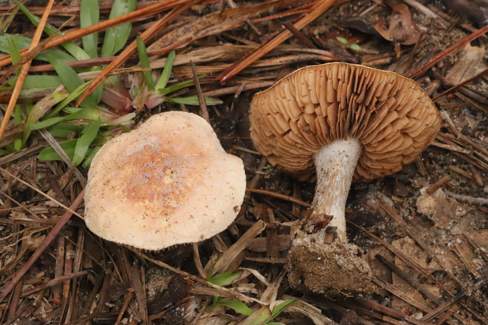 Hebeloma subfastibile (Photo: H. J. Beker)
Hebeloma subfastibile (Photo: H. J. Beker)Taxonomy
Full name: Hebeloma subfastibile Murrill, Proc. Fla Acad. Sci. 7 (2-3): 121 (1945) ["1944"]Genus: Hebeloma
Section: Naviculospora
Types: UNITED STATES: Florida: Gainesville, Alachua Co. (approx. 29.6516°N, 82.3248°W, alt. approx. 50 m a.s.l.) on grassy, shady soil in lawn under Quercus sp., 8 Jan. 1938, W.A. Murrill (Lectotype. herbarium acc. no. FLAS-F-16041, HJB1000407).
- arrow_drop_downarrow_drop_upType notesThe type material (FLAS-F-16041) was a mixed collection. The first part of the holotype material, referred to as ‘A’ has spores that are almost smooth and of dimensions on ave. 11.3 × 5.7 µm, representing a species from H. sect. Naviculospora; the second part of the holotype material (‘B’) and the isotype both have distinctly ornamented spores on ave. 12 × 6.9 µm and should be referred to H. sordidulum. Given the spore description in the protologue, describing the spores as: “spores smooth, subfusiform … 11–13 x 5–6 µ[m]”, the first part had to be selected as lectotype.
Heterotypic synonyms:
- Hebeloma floridanum Murrill, Lloydia 7 (4): 321 (1945) ["1944"]
- arrow_drop_downarrow_drop_upEtymologyThe specific epithet underlines the supposed affinity with H. fastibile.
- arrow_drop_downarrow_drop_upOriginal diagnosisPileo convexo-plano, 2.5-4 cm. lato, roseo-isabellino; lamellis latis, pallidis; sporis subfusiformibus, glabris, ochraceo-ferrugineis, 11-13 x 5-6 μ; stipite albo, 3 X 0.5-1 cm.
- arrow_drop_downarrow_drop_upEnglish translationPileus convex to applanate, 2.5-4 cm broad, pinkish-isabelline; lamellae broad, pale; spores subfusiform, smooth, ochraceous-rusty, 11-13 x 5-6 μ; stipe white, 3 x 0.5-1 cm.
References
Description
- arrow_drop_downarrow_drop_upThresholds
Description of Hebeloma subfastibile based on 4 collections
- arrow_drop_downarrow_drop_upMacroscopic descriptionPileus: (25) 32–43 (45) mm diameter; shape often convex, occasionally umbonate or strongly umbonate; characters Not recorded; margin characters smooth; viscosity tacky when moist; colour variation often two color, occasionally unicolour; colour at centre often yellowish brown or clay-buff.
Lamellae: attachment emarginate; maximum depth up to 5 mm; number of complete lamellae 52–64; presence of tears absent; white fimbriate edge often weak, occasionally present.
Cortina presence: no.
Stipe: (22) 25–48 (50) x (5) 6–7 (10) {median} x 4–7 (10) {basal} mm; stipe Q 3.0–7.1; base shape often cylindrical, occasionally clavate or tapering; floccosity often floccose or pruinose; rooting no; thick rhizoids at base absent;
Context: Texture firm; stipe interior hollow; stipe flesh discolouring no; slenderness measure 2.8–7.9; smell often raphanoid; taste weakly bitter where recorded.
Spore deposit colour: brownish olive.
Exsiccata characters: Not recorded.
- arrow_drop_downarrow_drop_upMicroscopic descriptionSpores: shape amygdaloid or navicular, often fusoid; colour in microscope often yellow or yellow brown, occasionally yellow pale; guttules variable. papilla variable often weak; Spore Code: O1 O2; P0 (P1); D1 D2.
Basidia: 19–33 x 5–8 μm; ave. Q 3.4–4.2; spore arrangement 4 spored;
Cheilocystidia: main shape cylindrical, often clavate, gently clavate or clavate-lageniform or clavate-ventricose, occasionally ventricose; special features observed often irregular, septa or short, occasionally sparse; cheilocystidia ratios: A/M = 1.02–1.57; A/B = 0.90–1.45; B/M = 0.89–1.28.
Pleurocystidia: none seen.
Ixocutis: epicutis thickness (measured from exsiccata) up to 75 μm; ixocutis hyphae width up to 6 μm; ixocutis hyphae encrustation often no, occasionally yes; shape of trama elements beneath subcutis often cylindrical, occasionally ellipsoid, isodiametric or thickly sausage-shaped up to 17 μm wide.
Caulocystidia: Similar to cheilocystidia but larger, up to 75 μm.
- arrow_drop_downarrow_drop_upSpore measurements
- arrow_drop_downarrow_drop_upCheilocystidia measurements
- arrow_drop_downarrow_drop_upHabitat and distributionHebeloma subfastibile's preferred habitat appears to be mixed parkland, mixed woodland or lawn with grassy, mossy, sandy soil, decomposed litter or grassy, shady soil. Where only one possible associate was recorded, the most commonly recorded associate was Pinus (50.0%) but Quercus (50.0%) were also recorded. In these cases the most commonly recorded families were Pinaceae (50.0%) and Fagaceae (50.0%). We have additional records where Fagus was recorded as a possible associate, but for these collections a number of possible associates were mentioned. Overall the most commonly recorded families are Pinaceae (66.7%) and Fagaceae (66.7%) The growth habit of our collections was occasionally gregarious, scattered or solitary.
According to our current collections, the species is found only in Northern America. On the continent, collections has been found in the WWF biomes The World Wildlife Fund (WWF) have divided the world into 867 terrestrial ecoregions. The ecoregion here is estimated by mapping from the GPS coordinates of the collection using data made available by Dinerstein et al (2017). Use this webtool to explore the ecoregions visually or see a full list of current ecoregions on Wikipedia. temperate conifer forests (50.0%) and temperate grasslands, savannas & shrublands (50.0%), specifically including the ecoregions: Piney Woods (50.0%) and Southeast US conifer savannas (50.0%). From collector information, it appears collections have been found in the 14.5 Urban Areas (66.7%) and 1.4 Forest – Temperate (33.3%) IUCN habitats We map from the collector's description of the habitat to the International Union for Conservation of Nature (IUCN)'s definition using a standardised set of rules. Please see this page for a full list of IUCN habitats.. Within Northern America we have records from Southeastern U.S.A. (Florida and Louisiana) and South-central U.S.A. (Texas).
- arrow_drop_downarrow_drop_upCommentaryThe short, irregular but largely cylindrical cheilocystidia of the lectotype together with the amygdaloid to navicular shaped spores suggest H. sect. Naviculospora. No European members of this section have an ecology and morphology corresponding to this taxon. In particular, within this section, the spores on average greater than 10 µm long and with an average Q in excess of 1.90 and not strongly dextrinoid, characterize this species. Unfortunately, no molecular data was generated from the lectotype. This species should be accepted as current. Hebeloma floridanum Murrill 1945, illegitimately published and described above, is conspecific and is therefore listed as a synonym.
Geographic distribution
Phenology
- arrow_drop_downarrow_drop_upAdditional cited collections